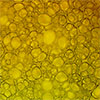| Mar 12, 2022 |
|
(Nanowerk News) Super-absorbent hydrogels can be engineered to absorb significant extents of water, in some cases with a swelling ratio as high as 3000 times their weight in water.
|
|
These polymer gels find applications that range from diapers to biomedical use to additives that keep the soil moist for plant growth.
|
|
Hydrogels are commonly made as macroscopic solids either as cubes or as beads and swell once exposed to a liquid – a process which is quite rapid for hydrogel microbeads (&sim 10 seconds) but can take up to 24 hours for much larger solids such as cubes or cylinders.
|
|
For a large piece of gel to swell rapidly, it is necessary to make it porous. The length scale relevant for diffusion will then be the pore diameter rather than the overall gel size. If the pores are microscale and are interconnected, then porous gels can swell at rates that are 100−1000-fold higher than those of nonporous gels.
|
 |
| Gel-swelling dynamics at different length scales. Dry gels are placed in water at t = 0 and allowed to swell (expand) to their final size. Swelling occurs by diffusion of water into the dry gel. (A) Microscale gel beads (∼10 µm size) swell in seconds to their final size. (B) A solid macroscale gel (∼1 cm size) takes ∼24 hours to expand to its final swollen size. (C) A macroscale gel with microscale pores expands much more rapidly compared to (B). In this study, one such porous gel is shown to expand to 4x its original size within 15 seconds. (Reprinted with permission by American Chemical Society)
|
|
If a macroscale hydrogel can expand rapidly, its expansion could be exploited for doing work, i.e., the chemical energy associated with gel expansion could be converted into mechanical energy.
|
|
This would make them interesting for using them as artificial muscles: The motion of a expanding and contracting gel can be harvested to perform mechanical work as an actuator: for instance, a cycle of gel expansion and contraction (in response to light, temperature, or salt) can be coupled to the lifting and lowering of a weight.
|
|
In a recent paper in ACS Applied Materials & Interfaces (“Superfast-Expanding Porous Hydrogels: Pushing New Frontiers in Converting Chemical Potential into Useful Mechanical Work”), researchers present a new approach that yields porous gels with an unprecedented combination of rapid swelling-expansion rates and high swelling extents.
|
 |
| Schematic of the procedure used to synthesize porous gels. (A) A foam of the monomers is prepared using a double-barreled syringe (DBS). One barrel of the DBS is an acidic solution of monomers, cross-linkers, and the hmC stabilizer, while the other barrel is a basic solution with the UV initiator. At the mixing tip of the DBS, CO2 gas is produced, and bubbles of the gas are stabilized by hmC chains. (B) The foam is polymerized by UV light for 2 min. (C) The bubbles in the foam are retained during the polymerization while a polymer gel network is formed around the bubbles. (D) The gel is dried under ambient conditions to give the porous gel. The photo (inset) reveals that the material is a robust solid with a sponge-like texture. (Reprinted with permission by American Chemical Society)
|
|
As illustrated above, this novel approach involves foaming of a monomer solution by injecting it out of a double-barreled syringe (DBS). The foam is generated in situ via the reaction of an acid and a base in the two barrels of the DBS, which combine to produce CO2 gas in the form of bubbles. The bubbles are stabilized by an amphiphilic biopolymer, hydrophobically modified chitosan (hmC), present in one of the barrels.
|
|
Monomers (acrylamide and acrylic acid, with cross-linkers) in the foam are then polymerized to form a gel around the bubbles. Subsequently, this gel is dried under ambient conditions to give a porous solid with a porosity >90% and a pore size around 200 µm.
|
|
When this dry gel is added to water, it absorbs water rapidly until an equilibrium is achieved in 15 seconds at about 300x its weight. The hydrogels can then be shrunk by decreasing the pH, adding salt, or adding ethanol.
|
|
The swollen gel is robust enough to be picked up by hand. Reversible expansion−contraction cycles, where the gel expands by absorbing 100x water and then contracts by expelling 100x water, can be completed in about 60 seconds.
|
|
The authors report that they have used gel expansion to lift loads against gravity. A 40 mg gel is able to perform &sim0.42 mJ of work over 40 seconds, which translates into a power density of 260 mW/kg.
|
|
The researchers conclude that this ability to harness the chemical potential of the gel to do useful mechanical work could be a game changer for many applications, including in the creation of artificial muscles.
|




